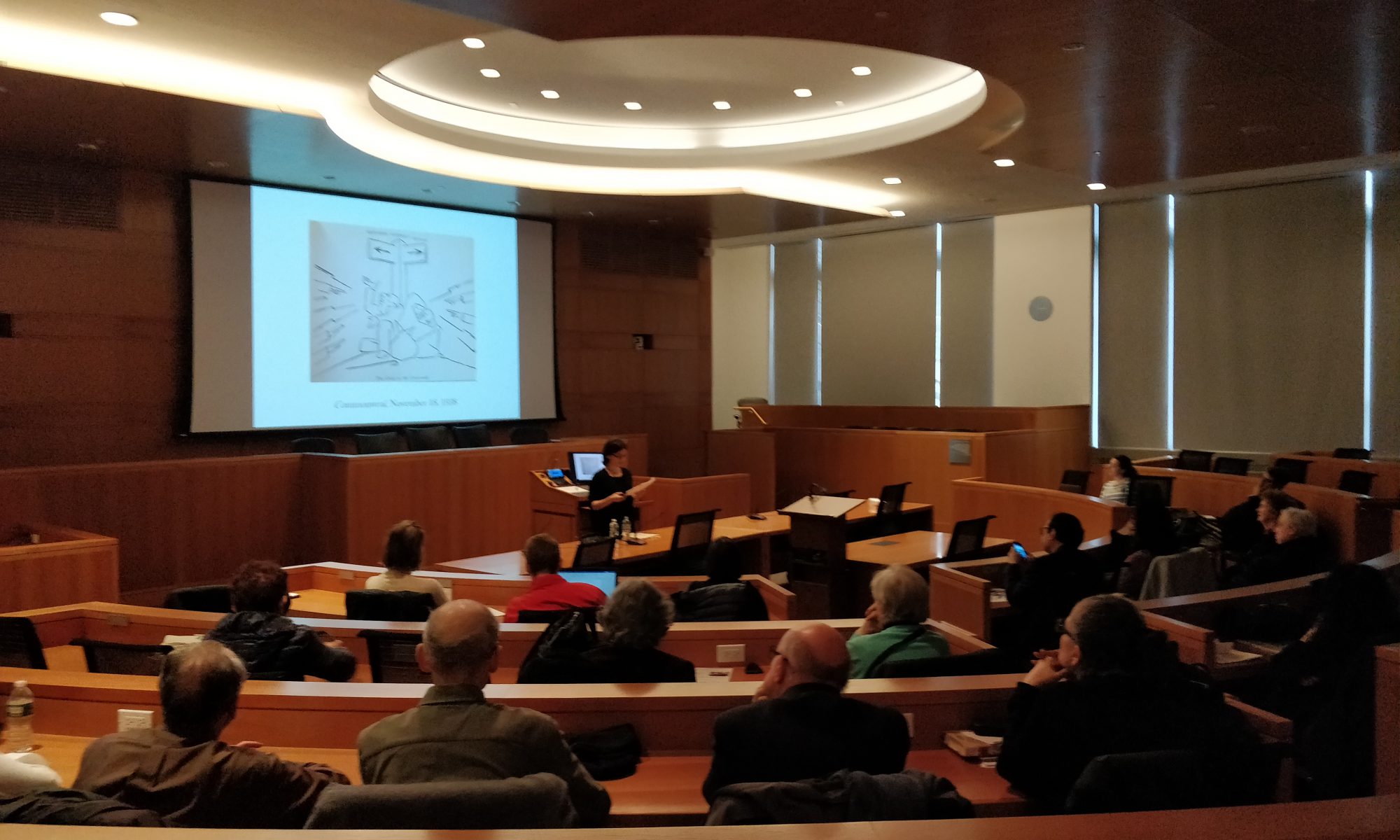by Magda Teter
Over the last months, I have been reading books capturing the grieving response of the Jewish and Israeli writers, poets, and thinkers to the horrific events of October 7th that confounded, as Rabbi Beth Nadich put it, “the entire rhythm” of Jewish lives and the annual cycle. When Hanukkah came, Nadich wrote in her “Rings of the Year: Rosh Ha-Shanah”,
Latkes and sufganiyot felt wrong – how could it be Hanukah when it was still October? How could we have arrived at Purim, and how could we celebrated in the traditional way, when our hostages still languished in captivity? How was it Pesach already, with its order, when the world was still erupting in chaos that took different shapes, but didn’t seem to end? How have we somehow lived through the entire year?[1]
These poets, writers, rabbis, and scholars express their grief, anger, sadness, and sometimes also hope. Leah Cassorla, in her poem, published in Hebrew and English, demands of God to “Answer Us”/ענינו and asks
Don’t hide from us
And You, return to us.
Answer us, Answer us
We await you
Give response, give
Compassion, give peace.[2]
And Tsur Gueta’s poem, whose title refers to the verse from Genesis, “Darkness over the Surface of the Abyss”/חֹ֖שֶׁךְ עַל־פְּנֵ֣י תְה֑וֹם speaks of despair felt on that day:
My teacher Michal once asked us
“Who can tell me the meaning of the verse,
‘The earth was chaos and confusion
with darkness over the surface of the abyss”?
All these years, from then to this very day,
That question has echoed within me, the teacher’s eyes
As she was looking for a raised hand, echoed in me
That all-encompassing silence echoed in me.
On October 7th the ringing telephone echoed
In the silent home of my teacher Michal.
“It’s me,” I said, “Here’s your chaos and confusion.
Here’s your darkness. Here’s your abyss. Goodbye.”[3]
The poems and essays in the bilingual Shiva/שבעה Poems of October 7 edited by Rachel Korazim, Michael Bohenen, and Heather Silverman; These Holy Days: A High Holidays Supplement After October 7 edited by Ora Horn Prouser and Rabbi Menachem Creditor, and an earlier publication prepared for Passover, Seder Interrupted: A Post October 7 Haggadah Supplement, also edited by Ora Horn Prouser and Rabbi Menachem Creditor,[4] are now part of the history of Jewish literary responses to violence that have shaped Jewish collective memory, from the biblical times, which bequeathed us such profound statements of grief such as the Book of Lamentations, through the medieval laments after the crusades, expulsions, the burnings of Jewish bodies and books, to early modern poems and chronicles of suffering in the aftermath of the Khmelnytskyi uprising, to the gut-wrenching poems and prayers written after pogroms in Ukraine or exclusionary anti-Jewish violence in Palestine under the British Mandate. Some of the poems draw inspiration directly from earlier texts and prayers, some create new ways of expressing the pain.
Texts from centuries ago also engaged in similar dialogue between the past and the present. The opening stanzas of a kinah, a dirge, commemorating the Jews of Trento, after they had been murdered in the aftermath of the notorious blood libel of 1475 offer a broader timeless expression of pain before recounting the experiences of the Jewish martyrs in Trento:
How can I raise my head?
I will wallow in the dust
I will weep bitterly—when will I be free?
And how can I be comforted?
There is no healing in this disastrous day
How we are ground as in a mortar
Our troubles are exceedingly great
And how can I be comforted?[5]
Yehuda Abravanel’s poem written in 1503 to his son, trapped in Portugal after Jews were expelled from Spain and then forcefully converted in Portugal without ability to leave, expresses pain and hope grounded in trust in God:
O dear gazelle! What makes you tarry so?
Why do you thus crush a father’s heart?
Why do you aim your arrows at my inmost parts?
Why do you dim the light by sending clouds
and make the shining seem like night to me?
The moon is always darkened in my sight,
my star is blotted out by clouds;
no sun’s ray ever penetrates my home
or crosses my doorsill to reach my beams.
My roses never bloom on Sharon’s plain,
my grasses never feel the driving rain.
You steal my very sleep with the thought of you –
am I sleeping or awake? I cannot tell.
I cannot touch my food, for even honey
stings, and sweets taste venomous to me.
Miserably I nibble coal-burnt crusts,
moistening with tears my dried-out bread.
My only drink is water mixed with tears;
the blood of grapes does not come near my mouth.
I’m drunk with nothing more than water,
like a Nazirite or one of Reehab’s sons.
But when I dream of your return, and when
I picture in my mind’s eye how you look,
how good my fortune seems! The rose returns
to dress my cheek in sanguine once again.
I sleep and find sleep sweet; I wake
refreshed, delighting in your lingering image.
The water that I drink is sweet, and even earth
tastes sweet when I imagine you are here.
But when I think about our separation,
heat blasts my heart, a desert wind within.
I seem like one dismayed or in a faint,
diminished somehow and reduced in size.
‘fhe thought of you is joy to me and pain,
tonic and torment are from you, balm and bane.
I have your image graven on my heart,
but also our separation in my core,
and any joy your image brings to me
cannot outweigh the reproach your absence speaks.
Your absence frustrates all my plans,
your exile blocks, diverts my roads.[6]
These centuries-old poems resonate today, connecting in collective memory the past with the present. In the days following October 7, the viscerally realistic opening stanzas of Haim Nachman Bialik’s combative poem “In the City of Slaughter,” written in the aftermath of the Kishinev pogrom of 1903, had particular resonance. The Orthodox paper The Jewish Star published it on the front page on October 13, 2023, and, for me, too, this poem vividly put in verse what we were leaning about the extent of horrors on October 7th:
Arise and go now to the city of slaughter;
Into its courtyard wind thy way;
There with thine own hand touch, and with the eyes of
thine head,
Behold on tree, on stone, on fence, on mural clay,
The spattered blood and dried brains of the dead.
Proceed thence to the ruins, the split walls reach,
Where wider grows the hollow, and greater grows the
breach;
Pass over the shattered hearth, attain the broken wall
Whose burnt and barren brick, whose charred stones reveal
The open mouths of such wounds, that no mending
Shall ever mend, nor healing ever heal. [7]
The poems and essays in the three books that deal with October 7 are less visceral than Bialik’s “In the City of Slaughter” but the pain, grief, despair, and even anger are no less palpable. While they express some glimmer of hope, in light of the destruction and loss of life on and since October 7, they also echo the disquiet in a 1947 poem by Henia Karmel, a Cracow ghetto survivor, capturing the survivors’ inability to feel joy of freedom and of the end of the war:
When freedom came, it was strange:
Chilly, blurred unrecognizable.
I was so surprised
I could only stare straight into space.
My heart still beat
But when I shut my eyes, I felt sick
Unable to face freedom.[8]
The poems and essays responding to October 7th are drawing from and becoming a part of Jewish collective memory, shaped by Jewish literary works from biblical texts to liturgy to poems, and a literary tradition that has provided Jews, as David Roskies has shown, with “usable past” in times of crisis.[9]
Bibliography
Constable, Olivia Remie. Medieval Iberia: Readings from Christian, Muslim, and Jewish Sources. The Middle Ages Series. Philadelphia: University of Pennsylvania Press, 1997.
Halevi, Shlomo. “Kinah: Lament for the Victims of Trent.” Translated by Sylvia A. Herskowitz. In Medieval Justice: The Trial of the Jews of Trent. New York: Yeshiva University Museum, 1989 (1475).
Horn Prouser, Ora, and Menachem Creditor, eds. Seder Interrupted: A Post October 7 Haggadah Supplemen. n.p.: Monce, IL, 2024.
Horn Prouser, Ora, and Menachem Creditor, eds. These Holy Days: A High Holidays Supplement after October 7. n.p.: Orlando, FL, 2024.
Korazim, Rachel, Michael J. Bohnen, and Silverman Heather, eds. Shiva: שבעה Poems of October 7. Cambridge, MA: The Institute for Jewish Research and Publications, 2024.
Roskies, David G. The Jewish Search for a Usable Past. Helen and Martin Schwartz Lectures in Jewish Studies. Bloomington, IN: Indiana University Press, 1999.
Wolfson, Leah. Jewish Responses to Persecution: 1944–1946. Lanham, Maryland: Rowman & Littlefield Publishers, 2015. Book.
[1] Rabbi Beth Nadich, “Rings of the Year: Rosh Ha-Shanah” in Ora Horn Prouser and Menachem Creditor, eds., These Holy Days: A High Holidays Supplement after October 7 (n.p.: Orlando, FL, 2024), 17-19.
[2] Leah F. Cassorla, “Answer Us”/ענינו in Horn Prouser and Creditor, These Holy Days: A High Holidays Supplement after October 7, 23.
[3] Tzur Gueta, “Darkness over the Surface of the Abyss”/ חֹ֖שֶׁךְ עַל־פְּנֵ֣י תְה֑וֹםin Rachel Korazim, Michael J. Bohnen, and Silverman Heather, eds., Shiva: שבעה Poems of October 7 (Cambridge, MA: The Institute for Jewish Research and Publications, 2024), 2-3.
[4] Ora Horn Prouser and Menachem Creditor, eds., Seder Interrupted: A Post October 7 Haggadah Supplemen (n.p.: Monce, IL, 2024).
[5] Shlomo Halevi, “Kinah: Lament for the Victims of Trent,” in Medieval Justice: The Trial of the Jews of Trent (New York: Yeshiva University Museum, 1989 (1475)).
[6] Olivia Remie Constable, Medieval Iberia: Readings from Christian, Muslim, and Jewish Sources, The Middle Ages Series, (Philadelphia: University of Pennsylvania Press, 1997), 357-363.
[7] The Jewish Star, October 13, 2024, posted online on October 11, 2024: https://www.thejewishstar.com/stories/in-the-city-of-slaughter-1904,22912
[8] Wolfson Leah, Jewish Responses to Persecution: 1944–1946, Jewish Responses to Persecution, (Lanham, Maryland: Rowman & Littlefield Publishers, 2015), Book, xxv.
Magda Teter is Professor of History and the Shvidler Chair of Judaic Studies at Fordham University. She is the author and co-editor of several books, most recently, Blood Libel: On the Trail of An Antisemitic Myth (2020) and Christian Supremacy: Reckoning with the Roots of Antisemitism and Racism (2023). Her new book, Blood Libels, Hostile Archives: Reclaiming Interrupted Jewish Lives is forthcoming in March 2025.


